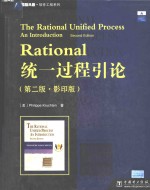

Rational统一过程引论 第2版PDF电子书下载
- 电子书积分:11 积分如何计算积分?
- 作 者:(美)克鲁奇顿著
- 出 版 社:北京:中国电力出版社
- 出版年份:2003
- ISBN:7508315170
- 页数:298 页
Part Ⅰ The Process 1
1 Software Development Best Practices 3
The Value of Software 3
Symptoms and Root Causes of Software Development Problems 4
Software Best Practices 5
Develop Software Iteratively 6
Manage Requirements 8
Use Component-Based Architectures 9
Visually Model Software 11
Continuously Verify Software Quality 12
Control Changes to Software 14
The Rational Unified Process 15
Summary 16
2 The Rational Unified Process 17
What Is the Rational Unified Process? 17
The Rational Unified Process as a Product 18
Process Structure:Two Dimensions 22
Software Best Practices in the Rational Unified Process 23
Other Key Features of the Rational Unified Process 30
A Brief History of the Rational Unified Process 32
Summary 34
3 Static Structure:Process Description 35
A Model of the Rational Unified Process 35
Workers 36
Activities 38
Artifacts 40
Workflows 43
Additional Process Elements 47
A Process Framework 50
Summary 51
4 Dynamic Structure:Iterative Development 53
The Sequential Process 53
Overcoming Difficulties:Iterate! 60
Gaining Control:Phases and Milestones 61
A Shifting Focus across the Cycle 64
Phases Revisited 66
Benefits of an Iterative Approach 76
Summary 78
The Importance of Models 81
5 An Architecture-centric Process 81
Architecture 82
The Importance of Architecture 82
A Definition of Architecture 84
Architecture Representation 85
An Architecture-centric Process 90
The Purpose of Architecture 92
Component-Based Development 93
Other Architectural Concepts 94
Summary 96
6 A Use-Case-Driven Process 97
Definitions 97
Identifying Use Cases 103
Evolving Use Cases 104
Organizing Use Cases 105
Use Cases in the Process 107
Summary 109
Part Ⅱ Process Workflows 111
Purpose 113
7 The Project Management Workflow 113
Planning an Iterative Project 114
The Concept of Risk 117
The Concept of Metrics 119
What Is a Metric? 121
Workers and Artifacts 122
Workflow 123
Building an Iteration Plan 132
Summary 138
Purpose 139
8 The Business Modeling Workflow 139
Why Business Modeling? 140
Using Software Modeling Techniques for Business Modeling 141
Business Modeling Scenarios 143
Workers and Artifacts 144
Workflow 146
From the Business Models to the Systems 148
Modeling the Software Development Business 153
Tool Support 153
Summary 154
Purpose 155
9 The Requirements Workflow 155
What Is a Requirement? 156
Types of Requirements 158
Capturing and Managing Requirements 161
Designing a User-Centered Interface 162
Requirements Workflow 163
Workers in Requirements 165
Artifacts Used in Requirements 167
Summary 169
Tool Support 169
10 The Analysis and Design Workflow 171
Purpose 171
Analysis versus Design 171
How Far Must Design Go? 172
Workers and Artifacts 173
The Design Model 174
The Analysis Model 175
The Role of Interfaces 175
Component-Based Design 176
Artifacts for Real-Time Systems 176
Workflow 177
Tool Support 181
Summary 181
11 The Implementation Workflow 183
Purpose 183
Builds 184
Integration 184
Prototypes 185
Workers and Artifacts 188
Workflow 189
Tool Support 192
Summary 192
12 The Test Workflow 193
Purpose 193
Quality 194
Testing in the Iterative Lifecycle 194
Dimensions of Testing 195
The Test Model 198
Workers and Artifacts 199
Workflow 202
Tool Support 205
Summary 206
13 The Configuration and Change Management Workflow 207
Purpose 207
The CCM Cube 208
Workers and Artifacts 213
Workflow 215
Tool Support 218
Summary 219
14 The Environment Workflow 221
Purpose 221
Workers and Artifacts 222
Workflow 223
Summary 225
15 The Deployment Workflow 227
Purpose 227
Workers and Artifacts 229
Workflow 232
Summary 235
16 Typical Iteration Plans 237
Purpose 237
Defining the Product Vision and the Business Case 238
Building an Architectural Prototype 240
Implementing the System 244
Summary 247
17 Configuring and Implementing the Rational Unified Process 249
Introduction 249
The Effect of Implementing a Process 250
Implementing the Rational Unified Process Step by Step 252
Configuring the Process 258
Implementing a Process Is a Project 260
Summary 262
Appendix A:Summary of Workers 263
Appendix B:Summary of Artifacts 267
Acronyms 271
Glossary 273
Bibliography 279
Index 287
- 《催化剂制备过程技术》韩勇责任编辑;(中国)张继光 2019
- 《绿色过程工程与清洁生产技术 张懿院士论文集精选 上》《绿色过程工程与清洁生产技术》编写组编 2019
- 《化工传递过程导论 第2版》阎建民,刘辉 2020
- 《钢铁行业污染特征与全过程控制技术研究》周长波等 2019
- 《钢铁烧结烟气多污染物过程控制原理与新技术》甘敏,范晓慧著 2019
- 《食品过程工程》赵黎明主编 2020
- 《精神分析引论》(奥)西格蒙德·弗洛伊德著;黄珊译 2019
- 《工业过程控制及安全技术》王华忠编著 2019
- 《舰艇武器控制中的随机过程应用基础》卢发兴 2019
- 《模糊集引论 上》罗承忠,于福生,曾文艺编著 2019
- 《SQL与关系数据库理论》(美)戴特(C.J.Date) 2019
- 《魔法销售台词》(美)埃尔默·惠勒著 2019
- 《看漫画学钢琴 技巧 3》高宁译;(日)川崎美雪 2019
- 《优势谈判 15周年经典版》(美)罗杰·道森 2018
- 《社会学与人类生活 社会问题解析 第11版》(美)James M. Henslin(詹姆斯·M. 汉斯林) 2019
- 《海明威书信集:1917-1961 下》(美)海明威(Ernest Hemingway)著;潘小松译 2019
- 《迁徙 默温自选诗集 上》(美)W.S.默温著;伽禾译 2020
- 《上帝的孤独者 下 托马斯·沃尔夫短篇小说集》(美)托马斯·沃尔夫著;刘积源译 2017
- 《巴黎永远没个完》(美)海明威著 2017
- 《剑桥国际英语写作教程 段落写作》(美)吉尔·辛格尔顿(Jill Shingleton)编著 2019
- 《中国当代乡土小说文库 本乡本土》(中国)刘玉堂 2019
- 《异质性条件下技术创新最优市场结构研究 以中国高技术产业为例》千慧雄 2019
- 《中国铁路人 第三届现实主义网络文学征文大赛一等奖》恒传录著 2019
- 《莼江曲谱 2 中国昆曲博物馆藏稀见昆剧手抄曲谱汇编之一》郭腊梅主编;孙伊婷副主编;孙文明,孙伊婷编委;中国昆曲博物馆编 2018
- 《中国制造业绿色供应链发展研究报告》中国电子信息产业发展研究院 2019
- 《中国陈设艺术史》赵囡囡著 2019
- 《指向核心素养 北京十一学校名师教学设计 英语 七年级 上 配人教版》周志英总主编 2019
- 《《走近科学》精选丛书 中国UFO悬案调查》郭之文 2019
- 《清至民国中国西北戏剧经典唱段汇辑 第8卷》孔令纪 2018
- 《北京生态环境保护》《北京环境保护丛书》编委会编著 2018
